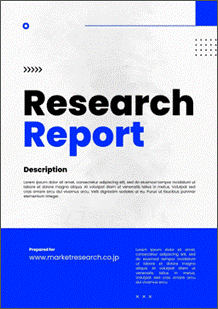 | • レポートコード:D0-MOR-AP0851 • 出版社/出版日:Mordor Intelligence / 2020年4月20日 • レポート形態:英文、PDF、122ページ • 納品方法:Eメール(受注後2-3営業日) • 産業分類:食品&飲料 |
| Single User | ¥629,000 (USD4,250) | ▷ お問い合わせ |
| Team User | ¥703,000 (USD4,750) | ▷ お問い合わせ |
| Corporate License | ¥1,110,000 (USD7,500) | ▷ お問い合わせ |
• お支払方法:銀行振込(納品後、ご請求書送付)
レポート概要
| 本調査レポートは、ノンアルコール飲料の世界市場について調査・分析した資料で、ノンアルコール飲料の市場概要、動向、セグメント別市場規模、地域別分析、競争状況、企業情報、市場機会分析などで構成されています。 |
Market Overview
The non-alcoholic beverage market is forecasted to reach USD 1252.54 billion by 2024, registering a CAGR of 4.7% during the forecast period (2019 – 2024). The booming demand for functional beverages in order to supplement health without altering the taste is propelling the non-alcoholic beverage market. Moreover, the increase in accessibility and regulations of non-alcoholic drinks globally is one of the key factors increasing the product preference leading to increased consumption. Whereas, the increasing health awareness and demand for nutrition-oriented products have affected the carbonated drinks market majorly.
Scope of the Report
The non-alcoholic beverage market offers a wide range of products among carbonated and non- carbonated beverages covering products, such as fruit and vegetable juice, functional drinks, RTD tea and coffee, and others. The others segment includes jelly beverages, rose syrup based beverages. The market is majorly operated by supermarket/ hypermarket, convenience store, online sales channels, and others. The other distribution channel includes drug stores, vending machines, and kiosks.
Key Market Trends
Flourishing Opportunities in Asia-Pacific
The Asia-Pacific food and beverage industry is growing with the highest possible rates, surpassing that of developed regions like Western Europe and North America. The region has a large and continuous growing middle-class consumer society, which indicates the presence of potential growth, specifically in the iced/RTD coffee drinks segment. Although the market is growing in all countries of Asia-Pacific, the high growth rate for this area is driven by the rapid development of the Chinese and Indian markets. Carbonated drinks is poised due to the largest segment in the non-alcoholic drinks segment. However the consumption of these carbonated beverages and soft drinks is expected to decline over sugar content and preference for healthier alternatives, such as 100% natural juice.
Online Sales Supplementing the Market Growth
Asia-Pacific is projected to show the highest growth rate in the sales of non-alcoholic beverage through specialty stores. However, the online retail sales for non-alcoholic beverages are growing at a faster rate. The segment is boosted by factors like the ease of availability and internet access, enabling the consumers to easily access the online shopping portals. The companies in the global market are placing their ranges of products over online retail spaces and trying to offer value-added services, like discounts to the consumers. This trend of shopping has expanded the overall global market.
Competitive Landscape
The market is highly fragmented due to a large number of companies involved in the manufacturing of functional beverage. Some of the major players in the market are PepsiCo Inc., the Coca-Cola Company, Danone S.A., and Nestlé S.A. offering a range of carbonated and functional beverages. Expansions and new agreement/ partnership strategies are some of the most preferred strategies for the non-alcoholic drinks industry globally. The key players also form new agreements and partnerships with local players to increase their foot print in the local market and release new products, according to the consumers’ changing preferences.
Reasons to Purchase this report:
– The market estimate (ME) sheet in Excel format
– Report customization as per the client’s requirements
– 3 months of analyst support
1 INTRODUCTION
1.1 Study Deliverables
1.2 Study Assumptions
1.3 Scope of the Study
2 RESEARCH METHODOLOGY
3 EXECUTIVE SUMMARY
4 MARKET DYNAMICS
4.1 Market Drivers
4.2 Market Restraints
4.3 Porter’s Five Forces Analysis
4.3.1 Threat of New Entrants
4.3.2 Bargaining Power of Buyers/Consumers
4.3.3 Bargaining Power of Suppliers
4.3.4 Threat of Substitute Products
4.3.5 Intensity of Competitive Rivalry
5 MARKET SEGMENTATION
5.1 By Types
5.1.1 Carbonated Beverage
5.1.2 Non- Carbonated Beverages
5.1.2.1 Fruit and Vegetable Juice
5.1.2.2 Functional Drinks
5.1.2.3 RTD Tea and Coffee
5.1.2.4 Bottled Water
5.1.2.5 Others
5.2 By Distribution Channel
5.2.1 Supermarket/ Hypermarket
5.2.2 Convenience Store
5.2.3 Speciality Stores
5.2.4 Online Stores
5.2.5 Other Distribution Channels
5.3 Geography
5.3.1 North America
5.3.1.1 United States
5.3.1.2 Canada
5.3.1.3 Mexico
5.3.1.4 Rest of North America
5.3.2 Europe
5.3.2.1 Spain
5.3.2.2 United Kingdom
5.3.2.3 Germany
5.3.2.4 France
5.3.2.5 Italy
5.3.2.6 Russia
5.3.2.7 Rest of Europe
5.3.3 Asia-Pacific
5.3.3.1 China
5.3.3.2 Japan
5.3.3.3 India
5.3.3.4 Australia
5.3.3.5 Rest of Asia-Pacific
5.3.4 South America
5.3.4.1 Brazil
5.3.4.2 Argentina
5.3.4.3 Rest of South America
5.3.5 Middle East & Africa
5.3.5.1 South Africa
5.3.5.2 UAE
5.3.5.3 Rest of Middle East & Africa
6 COMPETITIVE LANDSCAPE
6.1 Most Active Companies
6.2 Market Share Analysis
6.3 Strategies Adopted by Leading Players
6.4 Company Profiles
6.4.1 PepsiCo, Inc.
6.4.2 The Coca-Cola Company
6.4.3 Danone S.A.
6.4.4 Nestle S.A.
6.4.5 Red Bull Gmbh
6.4.6 Keurig Dr Pepper Inc.
6.4.7 Parle Agro
6.4.8 Monster Beverage Corporation
6.4.9 Arizona Beverages USA
7 MARKET OPPORTUNITIES AND FUTURE TRENDS